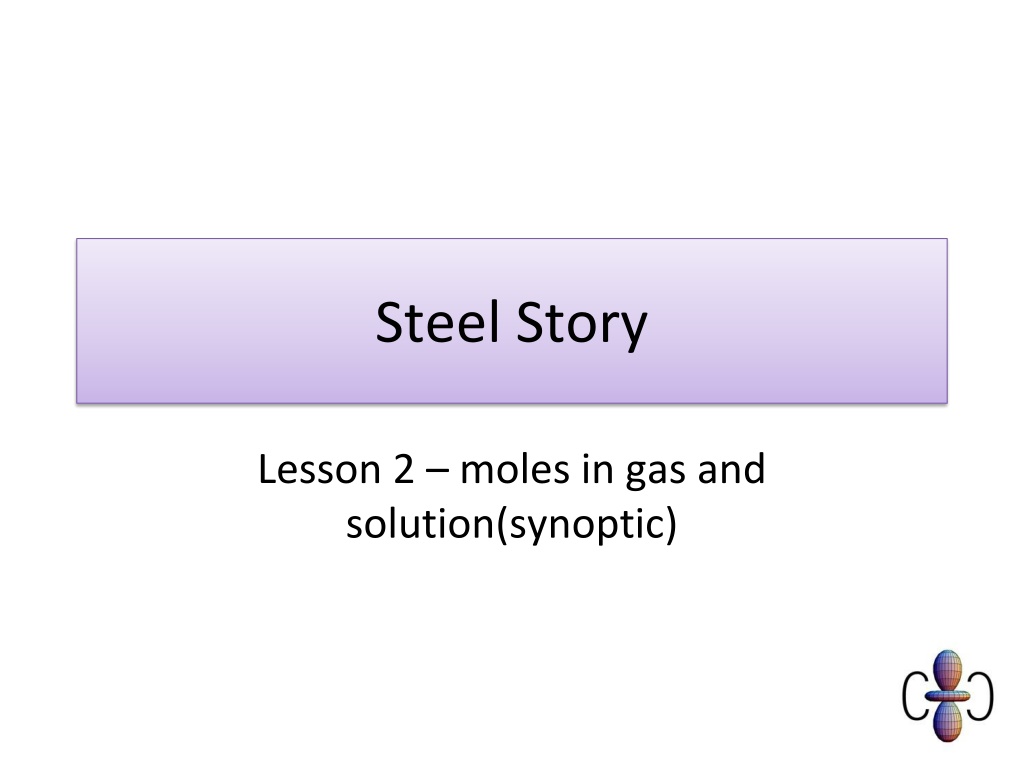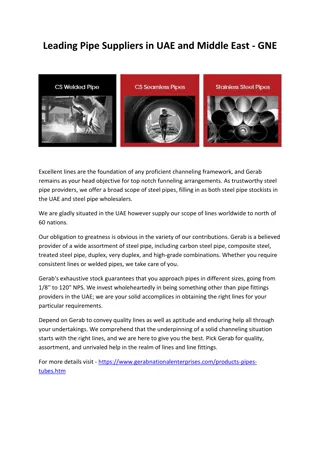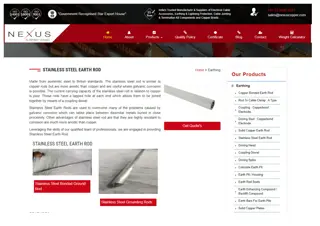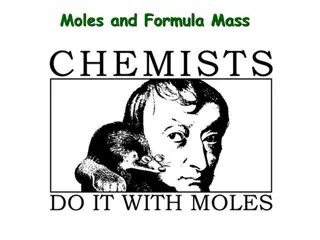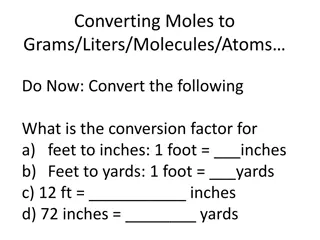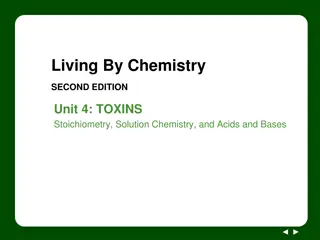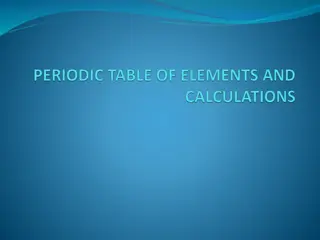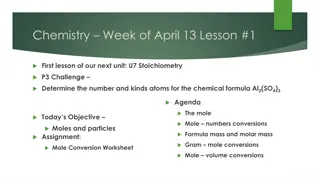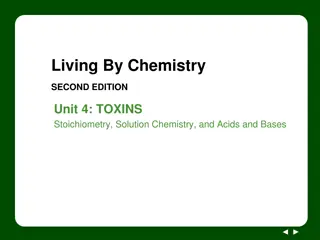Understanding Gas Moles and Volumes in Steel Story Lesson 2
Dive into the world of moles in gases and solutions in Steel Story Lesson 2. Learn about molar volumes, gas calculations, solution concentrations, and more. Explore the essential concepts and formulas to enhance your understanding of chemical equations and volumes in various conditions.
Download Presentation

Please find below an Image/Link to download the presentation.
The content on the website is provided AS IS for your information and personal use only. It may not be sold, licensed, or shared on other websites without obtaining consent from the author. Download presentation by click this link. If you encounter any issues during the download, it is possible that the publisher has removed the file from their server.
E N D
Presentation Transcript
Steel Story Lesson 2 moles in gas and solution(synoptic)
Objectives Must Recall the molar volume of gases at STP and RTP Should Carry out calculations involving gas volumes, concentrations of solutions, volumes of solution and moles Could Calculate reacting volumes of gas in balanced equations
Starter Draw all arrangements of the formulae below; Gas phase Number of moles = volume (in dm3) 24 Liquid phase Moles = concentration x volume
Specification statements Use the concept of amount of substance to perform calculations involving; Molecular formulae, Masses of reagents, Percentage yields, Volumes of gases, Volumes of solutions of known concentrations, Balanced chemical equations
Theory moles of gas Molar volume This is the volume per mole of gas molecules. When quoting the molar volume it is important to give the temperature as this effects the volume the gas occupies. At Standard Temperature (273K) and Pressure (STP) this value is 22.4 dm3 At Room Temperature (298K) and Pressure (RTP) this value is 24 dm3
What is 24 dm3? This is about the size of a beach ball It is interesting that the molar volume is the same for every gas. 1 MOLE HYDROGEN 1 MOLE NITROGEN 1 MOLE OXYGEN
Questions finding moles Find the number of moles of molecules in the following gaseous volumes at room temperature; a) 240 cm3 of Helium b) 480 cm3 of carbon dioxide CO2 c) 480 dm3 of sulfur dioxide SO2 d) 1200 cm3 of methane CH4 e) 1.2 cm3 of propane C3H8
Answers a) Moles = (240/1000)/24 = 0.010 mol b) 0.020 mol c) 20 mol d) 0.050 mol e) 0.000050 mol or 5.0 x 10-5 mol
Questions finding volumes What is the volume occupied by each of the following gases at room temperature; a) 4.0g of hydrogen molecules H2 b) 3.2g of methane CH4 c) 0.00048g of ozone O3 d) 17.6kg of carbon dioxide CO2 e) 6.8 tonnes of ammonia NH3
Answers Moles = mass Mr a) Moles of H2 molecules = 4.0g/2 = 2 mol volume = moles x 24 = 2 x 24 = 48 dm3 b) 4.8 dm3 c) 0.24 cm3 d) 9600 dm3 e) 9,600,000 dm3 moles = volume 24 (RTP)
AfL using whiteboards 1. Find the number of moles of molecules in 96cm3 of uranium (VI) fluoride. Show your working 2. What is the volume occupied by 4.0g of Argon atoms
Answers 1. 0.0040 mol 2. 2.4 dm3
Calculation reacting volumes Worked example A volume of 134.4dm3 of pure hydrogen is reacted with excess nitrogen in the presence of an iron catalyst. The reaction is carried out at STP. Assuming the reaction goes to completion, what volume of ammonia is produced?
STEP 1 Write a balanced equation 3H2 + N2 2NH3 STEP 2 Calculate number of moles of known substance Moles of hydrogen 22.4 STEP 3 Deduce reaction ratio from equation 3 moles of H2 produces 2 moles of NH3 so 6 moles of H2 will produce 4 moles of NH3. STEP 4 Convert number of moles into volume 4 moles of NH3 = 4 x 22.4 dm3 = 134.4 dm3 =6 mol = 89.6 dm3
Group work In your groups answer the following question. Propane burns in oxygen. What is minimum volume of oxygen required to completely combust 25dm3 of propane at STP?
Answer C3H8(g) + 5O2(g) One mole of any gas occupies a volume of 22.4 dm3 at STP Moles of C3H8= 25/22.4 = 1.116 mol This reacts with 5 times as many moles of O2 5 x 1.116 = 5.58 mol 3CO2(g) + 4H2O (g) Volume of gas = 5.58 x 22.4 = 125 dm3
Exam question Calcium carbonate, CaCO3, reacts with hydrochloric acid as shown in the equation below. CaCO3(s) + 2HCl (aq) CaCl2(aq) + H2O(l) + CO2(g) 7.50 10 3 mol CaCO3 reacts with 0.200 mol dm 3 HCl. (i) Calculate the volume, in cm3, of 0.200 mol dm 3 HCl required to react with 7.50 10 3 mol CaCO3. answer = ................................................. cm3 [2] (ii)Calculate the volume, in cm3, of CO2 formed at room temperature and pressure. answer = ................................................. cm3 [1] [Total 3 marks]
Answers with indicative marks (i) Moles of HCl = 1.50 10 2mol (1) volume of HCl (aq) = 75.0 cm3(1) ALLOW answers to 2 significant figures ALLOW ecf from wrong number of moles i.e ALLOW one mark for 37.5 (from incorrect 1:1 ratio) (ii) 180 (1) No other acceptable answer [3]
Exam question In 2000, the mass of CO2 emitted in the UK was equivalent to 1 kg per person in every hour. (i) Calculate the volume of 1 kg of carbon dioxide. Assume that 1 mole of CO2 occupies 24 dm3. volume = .......................... dm3 [2] (ii) The UK has set a target to cut CO2 emissions by 60% of the 2000 value by 2050. Calculate the reduction needed in the volume of CO2 emissions each hour per person if the target is to be met. answer: ........................... dm3 [1] [Total 3 marks]
Answer (i)moles CO2= 1000 /44 mol = 22.7 mol (1) volume CO2in 2000 = 22.7 x 24 = 545 dm3(1) reduction = (545 x 60)/100 = 327 dm3(1) (ii) [3]
Theory concentration of solutions When the volume of a solution and the number of moles are known , the concentration can be calculated using the equation; Moles = concentration (moldm-3) x volume (dm3)
Questions Calculate the number of moles present in each of the following; a) 25.0 cm3 of 0.1 moldm-3 hydrochloric acid b) 1.5 dm3 of 2.5 moldm-3 sodium hydroxide c) 3.0 cm3 of 2.0 moldm-3 sulfuric acid d) 20.0cm3 of 0.17 moldm-3 barium hydroxide e) 11.2cm3 of 0.5 moldm-3 sodium carbonate solution
Answers a) 25.0/1000 x 0.1 mol = 0.0025 mol b) 3.75 mol c) 0.006 mol d) 0.0034 mol e) 0.0056 mol
Exam question A student carries out a titration to find the concentration of some sulfuric acid. The student finds that 25.00 cm3 of 0.0880 mol dm 3 aqueous sodium hydroxide, NaOH, is neutralised by 17.60 cm3 of dilute sulfuric acid, H2SO4. H2SO4(aq) + 2NaOH(aq) Na2SO4(aq) + 2H2O(l) (i) Calculate the amount, in moles, of NaOH used. (ii) Determine the amount, in moles, of H2SO4 used. answer = ................................... mol [1] (iii) Calculate the concentration, in mol dm 3, of the sulfuric acid. answer = ................................... mol [1] answer = ................................... mol dm 3 [1]
Answers Calculate correctly 0.0880 x25.0/1000 = 2.2x10-3OR 0.00220 mol ALLOW 0.0022 OR 2.2 10 3 mol (1) (a) (i) Calculates correctly 0.0022/2 = 1.10 10 3mol OR 0.00110 mol ALLOW 0.0011 OR 1.1 10 3 mol (1) ALLOW ECF for answer (i)/2 as calculator value or correct rounding to 2 significant figures or more but ignore trailing zeroes (ii) (iii) 0.00110 x 1000/17.60 = 0.0625 moldm-3OR 6.25 10 2mol dm 3(1) ALLOW 0.063 OR 6.3 10 2 mol dm 3 ALLOW ECF for answer (ii) 1000/17.60OR ECF from (i) for answer (i)/2 1000/17.60 as calculator value or correct rounding to 2 significant figures or more but ignore trailing zeroes
Summary Recall the molar volume of gases at STP and RTP Calculate reacting volumes of gas in balanced equations Carry out calculations involving gas volumes, concentrations of solutions, volumes of solution and moles
